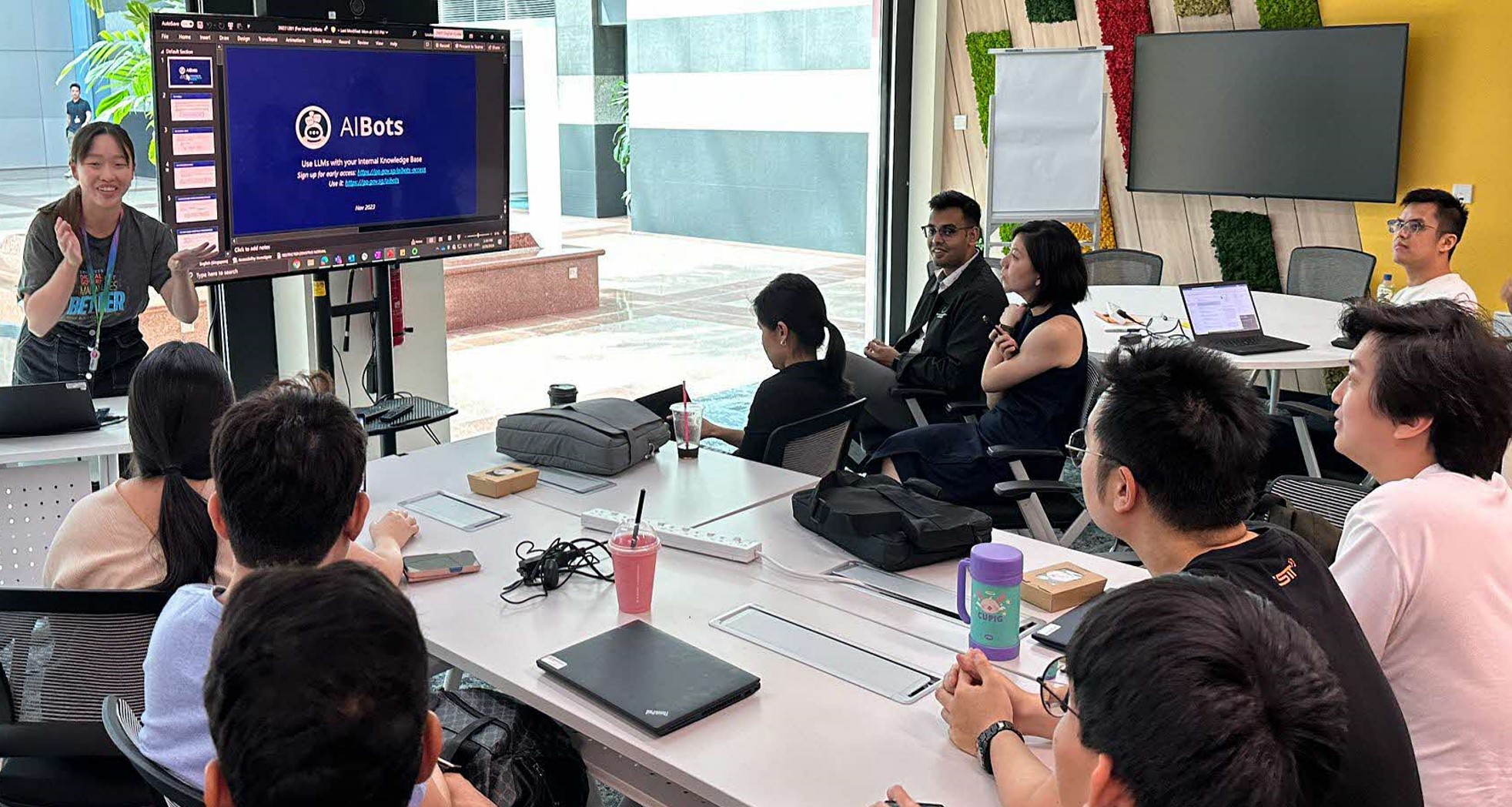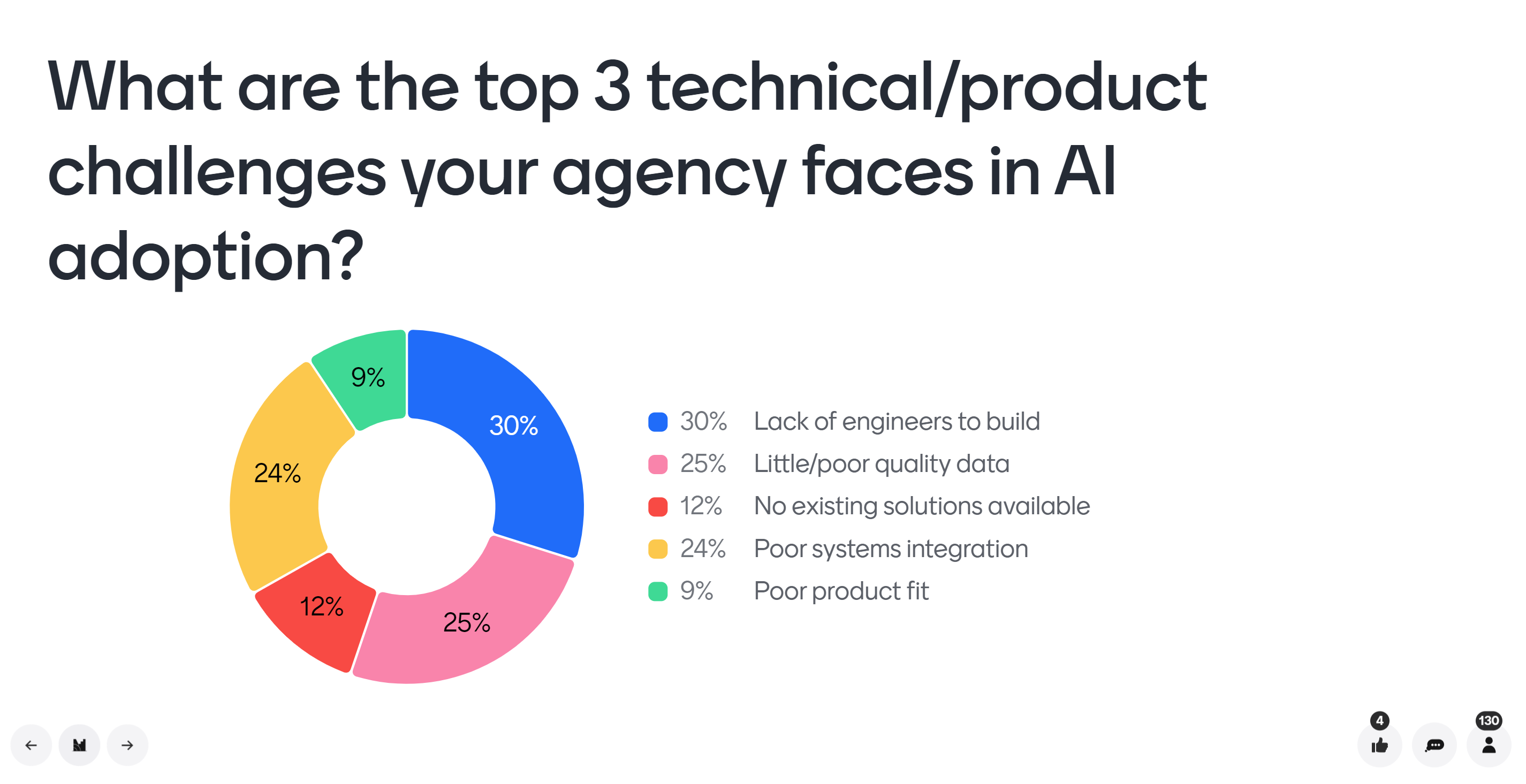Generating Momentum for AI Adoption in the Public Service
ETHOS Issue 27, January 2025

For the Government to promote and support Singapore’s next bound of AI development, it must lead by example. The Public Service must point the way forward for others, demonstrating how AI-enabled transformation can bring tangible benefits to public officers as well as the public.
The creation of a new dedicated Government team within the National AI Group (NAIG) speaks to Singapore's dedication to realising AI for the Public Good. The NAIG (Government) team's position at the centre of government offers us a bird's eye view of the many ongoing AI efforts across the Public Service. It allows us to help accelerate these ongoing efforts with economies of scale, by harnessing synergies or tackling shared hurdles, together with our implementing partner, the Government Technology Agency (GovTech). NAIG (Government) identifies and invests in the central enablers, such as computing power, funding and policy guidance, that agencies need to transform policymaking and citizen services with AI.
The advent of ChatGPT in late 2022 spurred many curious minds and digital innovators within the Public Service to tinker with new AI tools with record interest and speed. A poll across Government a mere 4 months after ChatGPT was released saw over 20 agencies surface a total of over 40 usecases for the new technology. Whoever said that public officers do not keep up with technology?
Since then, NAIG (Government) has seen AI tools applied to improve work in small ways but to great effect: such as using Large Language Models (LLMs) to summarise strategy documents or to identify key public concerns from news reports. These experiments tell us that good products and adoption are inextricably linked: rapid development of AI products intensifies adoption, which in turn generates helpful feedback to further improve the products—a powerful virtuous cycle.
Our approach has been to feed this virtuous cycle, by simultaneously providing space for our public officers to experiment with AI as they see fit, while making focused investments in key central drivers such as technical infrastructure, products and upskilling through training.
AI as a Flywheel
In engineering, a flywheel is a heavy wheel used to generate and transfer energy to other parts of a machine. Importantly, once it starts spinning, it eventually gains enough momentum to be able to keep going on its own for a long time without further intervention. With NAIG (Government) being a small team, we aim to achieve this flywheel effect: to encourage public officers to apply AI for better outcomes in a manner that is self-reinforcing and self-sustaining.
To get this momentum going, we gather critical mass in four spokes which we believe not just push the wheel but keep it spinning: solving real problems, rapid solutioning, mass awareness, and skills and confidence.
Solving Real Problems
AI, while powerful, is ultimately a tool to be used to solve problems that resonate with officers. As anyone using ChatGPT has realised, the quality of the answer very much depends on asking the right question. Similarly, making sure that AI is a tool that is used to maximum effect depends on officers being able to identify and articulate the problem to be solved.
The public sector has therefore started helping officers with problem identification and articulation through central ideathons and related platforms. In early 2023, GovTech introduced a central platform to solicit ideas for problems to tackle. Known as LaunchPad,1 the platform even deploys AI to help users sharpen problem statements, with a ‘magic wand’ beta feature using an LLM to reframe problems as ‘How Might We’ statements. Old and new problem statements are shown side by side so users can see how their statements could be sharper and clearer. LaunchPad users can also view and vote for problems they relate with—enabling GovTech to prioritise common problems to help solve.
Central Provident Fund Board: Building AI Success on an Agency-Wide Foundation
At the CPF Board (CPFB), the AI journey began with the basics: the organisation had to first become Data-Smart. This involved getting the people ready to work with data, having the right processes to ensure data security and quality, and developing the tools and skills to make good use of data.
This foundation positioned CPFB well when generative AI took off. It set up a Core Team of officers from different departments to accelerate generative AI adoption. They raised awareness about the benefits of generative AI for work, engaging leaders and staff at all levels through talks and publications about generative AI applications and potential use cases.
They also looked to equip everyone with relevant skills and tools, developing a foundational generative AI course for all staff as part of CPFB’s upskilling roadmap, and conducting hands-on prompt engineering workshops. To encourage experimentation, they made AI tools more accessible: by automatically launching Pair on staff’s browsers, and making OpenAI API keys available for more complex solutioning.
CPFB teams are now exploring a range of AI use cases: from augmenting common tasks (such as search and retrieval) to supporting officers in specific domains—exploring capabilities that will carry the organisation into the future.
The SmartCompose Story: Tackling Slow Response to Public Queries
In early 2023, GovTech engineers met with the Housing & Development Board (HDB) to explore the potential of AI for the statutory board. HDB officers highlighted key pain points which included the need for live translation tools for on-site customer service staff to handle queries in languages they may not speak, as well as better ways to match buyers and sellers for resale flats. The GovTech team observed that these were department-specific issues not faced by the majority of HDB officers, nor did these problems necessarily require AI-based solutions.
This prompted further discussion. Another crucial gap identified was the need for more effective customer relationship management over email, especially as public queries were increasingly coming to HDB via email— not in-person. This had even led to customer service staff moving from counter services to email duties. While most email queries were similar, they were laborious and time-consuming to address, leaving HDB’s customer service teams less time to dedicate to more complex queries.
These email queries demanded substantial amounts of contextual information to generate appropriate recommendations — making the task suitable for AI to address. LLMs could also come up with dynamic, conversational and more customer-friendly responses instead of templated replies. Furthermore, the problem of handling email queries was one shared by many different public agencies. Here was a good priority problem to tackle with AI, since a solution could potentially be scaled for use across the Public Service.
This articulation of the core problem led to the development of SmartCompose: an LLM-powered tool streamlining workflows for HDB officers replying to citizens’ email queries. The tool generates sharp, comprehensive responses based on information from a select database of HDB information and policies. Referencing predefined resources ensures consistent, error-free communication with citizens, with faster response times. The tool also identifies and masks any Personally Identifiable Information (PII), protecting citizen privacy. Importantly, SmartCompose does not replace the job of a HDB customer service officer, but automates the more routine tasks they face in everyday work. This frees up valuable time so they can focus on more complex inquiries, and provide personalised support to citizens.
Rapid Solutioning
Once problems are identified and articulated, public officers must then be able to rapidly select and adapt existing AI products, or develop new products, to address their needs. Thanks to prior investments in building a strong engineering core, our Public Service can develop AI products at a steady pace. Recent examples of such home-grown products include Open Government Products’ Pair suite of AI-enabled ChatGPT-like tools, which supports general productivity in Public Service knowledge work such as speech-writing and research, and GovTech’s Transcribe platform, which can recognise localised Singaporean speech while generating speech-totext transcripts of interviews, speeches, and meeting discussions.
For agencies without the right technical teams, NAIG centrally offers accessible development tools and industry-powered incubation initiatives, such as the AI Trailblazers programme in partnership with Google. These help agency teams create prototypes to address their needs, shortening product development times. This approach has yielded various success stories, including a prototype for improving the booking of People’s Association facilities and the National Library Board’s generative AI-enabled storytelling showcase StoryGen, created in partnership with Amazon Web Services.2
Rapid solutioning can also mean buying products off the shelf, because we are committed to leveraging promising commercial solutions. Some civil servants, for example, are trialling the use of Microsoft CoPilot to improve general productivity. Call centre operators and service providers in the government are trying out Wiz.AI, a commercial AI-powered chatbot, to improve customer service efficiency without sacrificing interactivity.
Not every new problem needs a new solution, either. GovTech has begun developing central platforms to cater to common needs across the Public Service. GovTech’s AI Bots platform lets public officers build their own Retrieval Augmented Generation bots—custom AI ‘assistants’ that generate content based on specified instructions and uploaded reference material specific to their work (such as policy documents or standard operating procedures). An AI bot can be created by non-technical officers in as little as 15 minutes.
Harnessing economies of scale, NAIG (Government) plays a crucial role in scaling AI projects to serve ever more officers, accumulate usage and feedback, and exponentially improve our AI offerings for officers.
Raising Mass Awareness
Because scale and reach matter, having novel solutions alone doesn’t keep the wheel spinning unless they are accompanied by robust marketing efforts.
The products with strong go-to-market strategies are also the ones with the most traction. Product teams reach out to public officers and potential users through sustained communications and how-to guides, as well as workshops, brownbags, and other hands-on sessions, often tailored to individual agencies. With the benefit of our centre-of-government perspective, NAIG (Government) supports marketing efforts by rolling out thematic campaigns that draw connections across various products and use-cases: such as a recent campaign on AI-enabled transcription tools for different contexts and needs.
Beyond product promotion, building a broader interest in AI amongst the public service is vital. Engaging the many pockets of AI builders and practitioners in the Public Service, we have found much common ground in their ambitions, concerns and challenges. To convene and grow this AI community, fortnightly online sharing sessions have been set up to ensure continuous knowledgesharing. These meetings have become a key platform for public officers to share their AI journeys with fellow practitioners—not just success stories but also critical lessons and shortcomings. For the developers amongst us, NAIG (Government) has also started ‘AI Wednesdays’—an informal weekly gathering where AI builders can co-work and network. These have been helpful for developers to exchange more technical pointers and initiate partnerships.

‘Progress reports’ on AI use across the government can also engage officers: we have recently started publishing a leaderboard of agencies with the highest AI use, driving playful competition amongst agencies. In tandem, these efforts have helped foster a high level of AI awareness across different agencies and sectors, as well as different levels of seniority and technical expertise.
Uplifting Skills and Confidence
The fourth spoke of the flywheel consists of the skills and confidence that the broad base of public officers will need to leverage AI. AI has to be used meaningfully—it should result in measurable benefits such as productivity savings or improved citizen interactions with Government. To achieve this, all public officers need at least a foundational level of AI fluency, which is best achieved through hands-on learning. GovTech is therefore working to develop e-learning modules on specific AI tools, focusing on applied knowledge and realtime use. Careful tracking of AI products’ usage trends also helps us to better understand how public officers use these tools, and what skills they may need to harness them better, or to integrate them into day-to-day workflows.
People learn by doing. Discovering new possibilities requires space to tinker, fail, and try again. NAIG (Government) strives to offer public officers not just AI tools, but a sandbox for experimentation that goes beyond the confines of what they can do at work. These new ‘playgrounds’ allow officers to try out different or new AI capabilities as they emerge, and test the limits of AI, so they can better recognise what problems can best be solved with AI, and what approaches, capabilities, models or techniques are most applicable in a given context. This will in turn strengthen their problem identification, lead to better products, and keep the flywheel spinning.

Keeping the Wheel Turning
A heavier flywheel spins longer: the more the Public Service uses AI, the more readily it will turn. We need to grow momentum at every spoke of the wheel. Every public officer has a part to play in propelling this momentum, by taking part in ideathons, co-creating AI tools, building community, or sharing knowledge. Our goal from the centre of government is not just to provide central resourcing, but to facilitate a virtuous cycle—one that generates more value than initially invested.
A flywheel carries energy not for its own sake, but to transfer it to power other parts of a system. In our endeavours to harness AI for the good of Singapore and the world, we believe that an AI-enabled government is a critical source of power for other parts of the ecosystem: from industry to society, both local and global. We cannot use AI to transform society without ourselves understanding AI as hands-on practitioners. Through our everyday experiments with AI in the Public Service, we could become powerful catalysts for change in Singapore and the world.
NOTES
- See: https://launchpad.gov.sg/
- National Library Board, “Central Public Library Reopens with a Kaleidoscope of Collections and Experiences for Everyone,” https://www.nlb.gov.sg/main/about-us/press-room-and-publications/ media-releases/2024/Central-Public-Library-Reopens-with-a-Kaleidoscope-of-Collections-and-Experiences-for-Everyone

